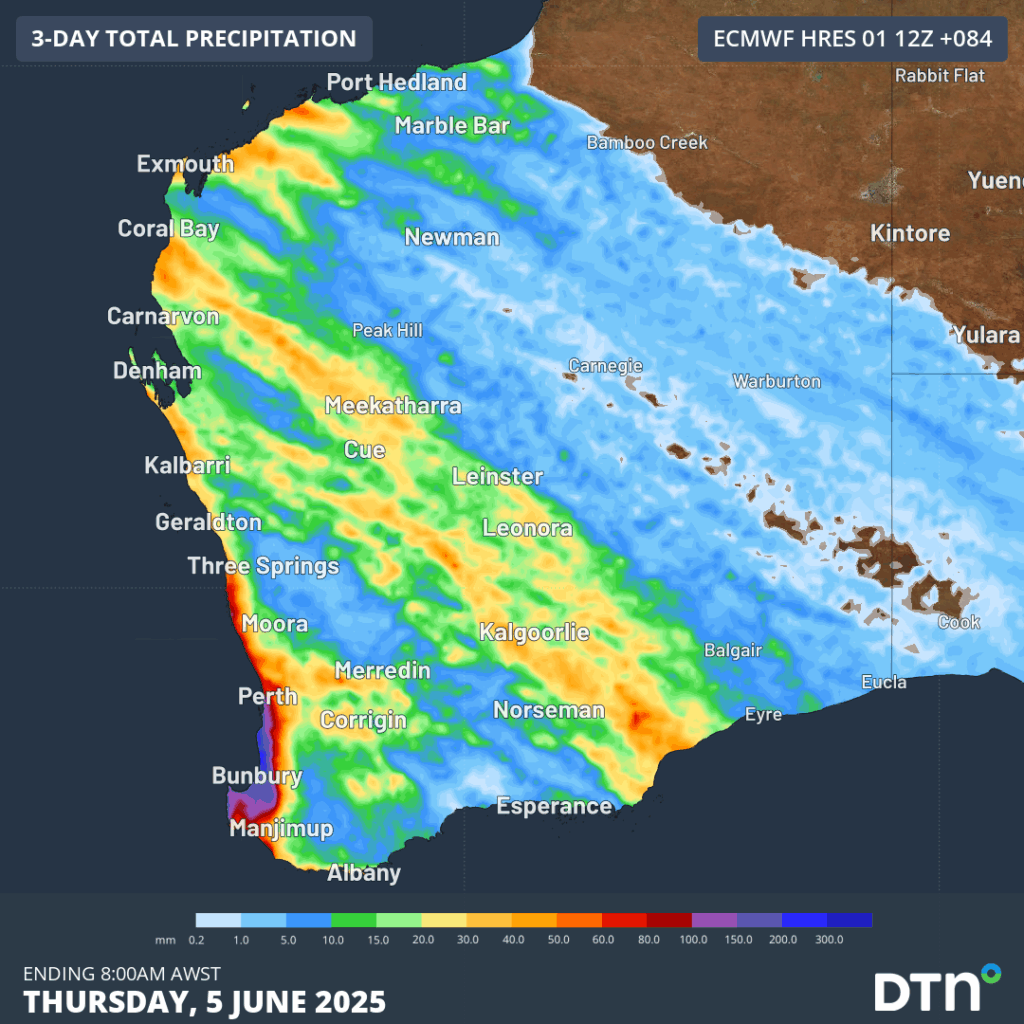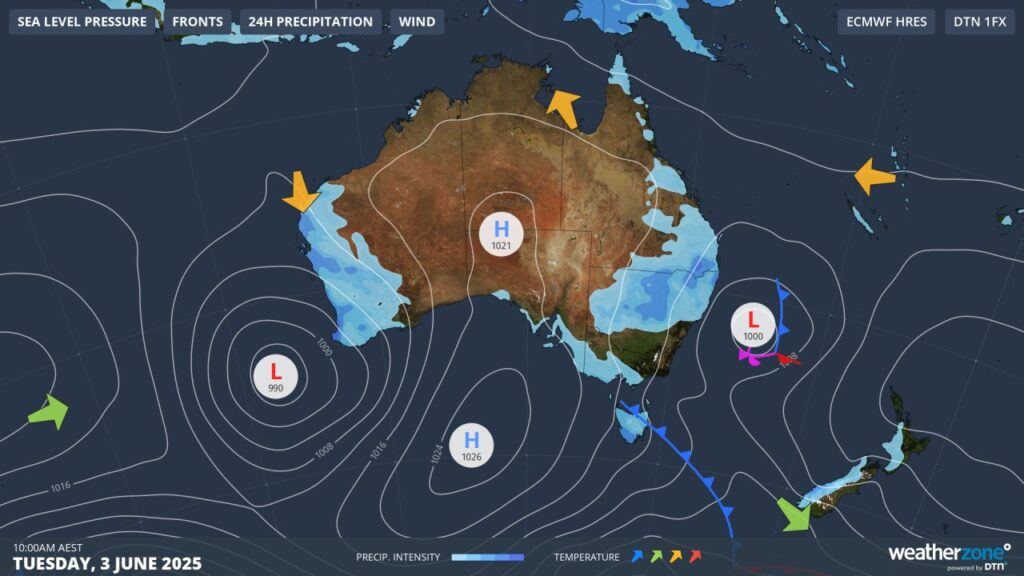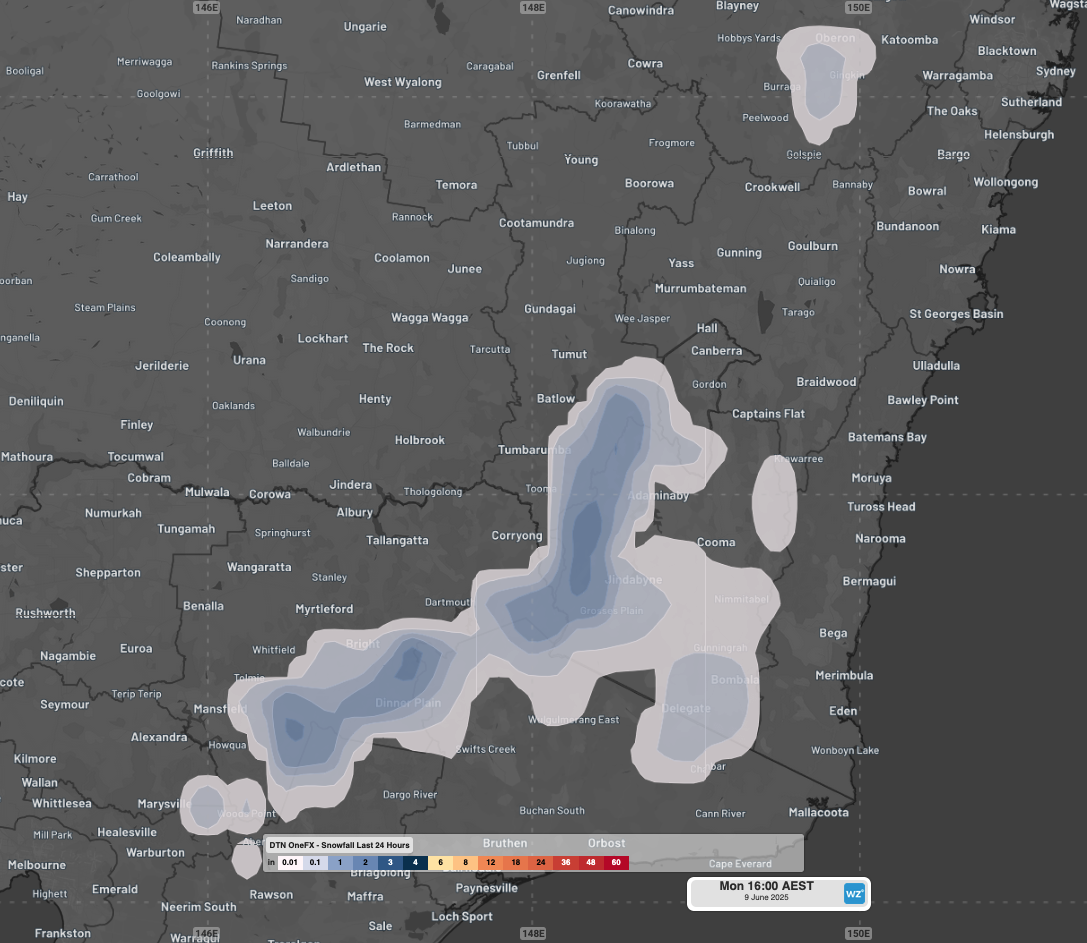Rain, storms and winds will move over western WA, while two significant lows and cold fronts will send a deep chill, rain and snow driving energy demand across Tasmania and southeastern mainland Australia, in an unmistakeable sign that winter is now here.
Southwest WA
Perth appears set for its heaviest rain of 2025 to date beginning later this Monday and extending through to Thursday morning . As a relatively slow-moving low pressure system approaches from the west, rainfall totals should exceed 50mm across those three days.
Locals will welcome the wet spell after an extremely dry start to the year. All five months of 2025 this far have seen below-average rainfall in Perth – and that includes May even though more than 50mm fell in total in the last eight days of the month.
While the southwest will be soggy, it won’t be particularly chilly, with the cold front on the back of the low sliding south of Cape Leeuwin (the continent’s southwesterly tip). Showers and thunderstorms will also extend up the West Coast, affecting parts of the mining areas in the Gascoyne and Pilbara over the coming days.

Image: Accumulated rainfall across Western Australia in the 84 hours to 8am Thursday, June 5, 2025, according to the ECMWF model.
Southeastern Australia system 1: A big chill and high energy demand between Tuesday and Thursday
The first cold outbreak due across the southeast this week will come via a cold front which will clip the southeast of the continent as it makes a beeline northwards.

Image: Synoptic chart for Tuesday, June 3, 2025.
The coldest maximums of the year so far are likely at many locations on Tuesday or Wednesday (or in some cases both) in the cold southwesterly airflow, while a low off northern NSW will bring showers to northeastern NSW, possibly extending into southeast Queensland.
Energy demand is forecast to surge, according to AEMO’s 7-day outlook, for NSW, Victoria and Queensland, with heating of office buildings expected to offset the chilly conditions outside.

Image: forecast energy demand for each state across the Nation Energy Market (NEM) over the coming days. Data source: AEMO
For the mainland alpine areas, a few centimetres of snow should accumulate this week, but the main effect of this system will be several nights of very cold and clear nights ideal for snowmaking in the wake of the front.
Heavy snowfalls that could really kick-start the season into action look much more likely from the second system due over the weekend – as well as even colder maximums across the southeast.

Image: Minimum temperatures across SE Australia for Thursday, June 5, according to the ECMWF model.
Southeast Australia system 2: Potentially heavy snowfalls this coming weekend
Towards the end of this week, a polar airmass is expected to surge towards southeastern Australia, accompanied by plentiful moisture.
This system will be a double punch, with the first cold front likely to bring snow to only the highest parts of the mainland alpine region above about 1700m on Saturday. Later on Sunday into Monday, a more significant cold outbreak is looming.
The low pressure system and associated cold front are expected to form what’s called a cut-off low, which means a pool of cold air gets cut off from the band of westerlies that circulates south of Australia in the mid-latitudes.
At present, the cold pool is projected to park itself right over the southeast, which could mean heavy snowfalls lasting two days or longer for the alpine region – with snow possible at lower elevations on Monday as the coldest air arrives.

Image: Early modelling suggests widespread snow accumulation on the mainland alpine region as well as across nearby elevated areas. Note that one inch equals approx. 2.5cm.
A word of caution for snow lovers: these sorts of systems can be hit and miss.
When a classic cold front embedded in the westerly stream sweeps across the SE mainland, you can reliably expect frequent widespread showers with snowfalls in the mountains. Cut-off lows are less predictable.
READ MORE: What is a cut-off low and why do they matter?
So it’s still very much a wait-and-see with the system which is still nearly a week away. But current indications are that hydropower and the opening weekend of the 2025 ski season could see persistent snowfalls that lay down a good base of snow for the season ahead.
How DTN APAC can help
The energy market
DTN APAC supplies precise weather intelligence to over 75% of the National Energy Market (NEM); and is the trusted provider for the Australian Energy Market Operator (AEMO).
DTN APAC’s next-generation nowcasting and forecasting system, OpticastTM, is independently proven to outperform other industry models, allowing energy traders to respond rapidly to changing conditions. From 14 day forecasting to seasonal outlooks, you have access to complete and powerful weather intelligence giving you the confidence to make the best call.
Meeting the needs of the changing market, DTN APAC utilises high-resolution modelling and local knowledge to provide 5-min granularity observations and forecasts, optimising your market bidding and maximising your profits. These, coupled with briefings from our energy meteorologists, give you full awareness of the associated risk.
Benefit from specialised indices such as apparent temperature, Cooling/Heating Degree Days (CDD/HDD) and Effective Degree Days (EDD) to help accurately predict demand. You can get a clear picture of forecast conditions across the market and quickly assess heat/heatwave potential from 14 days out to 12 months
No matter where your energy trading focus lies, we have the power generation and weather insights to inform your critical decisions, keeping you ahead of the curve.
Hydropower
Using Opticast’s nowcasting and forecasting capabilities, you will have long-term outlook covering rainfall and extreme heat events out to 12 months. This can significantly improve your planning as you integrate the data with site-specific hydrological parameters.
DTN APAC’s Opticast is an ultra-local forecasting system, independently proven to be the best performing of its type in Australia. Providing an unprecedented level of accuracy and precision, Opticast rapidly updates every 10 minutes, intelligently adapting to local observations, and corrects forecasts based on historical evidence. Wherever you are based, we can provide you with the most accurate nowcasting and forecasting data out to 14 days so that you can mitigate operational and safety risks, and plan to make the most of severe weather windows.
With renewables making up more of Australia’s energy mix every year, we want to support your business to make informed critical decisions and improve your overall generation and safety.
Learn more about our large range of industry leading or email us at









